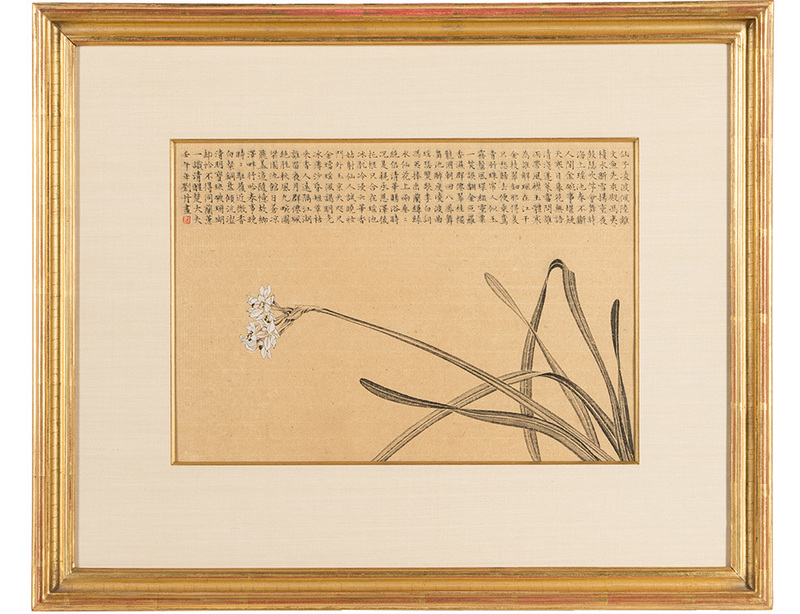
Fundamentals of Connoisseurship: Collecting Chinese Ink Painting at Hindman
The works in the field of Chinese ink paintings range from classical paintings through to contemporary paintings that employ archaic themes, materials, and techniques.
Classical Chinese paintings usually encompass styles from the 12th through 19th centuries, whereas artistic works produced in the 20th century onward are generally considered Chinese modern art. At the turn of the 20th century, under continuous military, economic, and cultural pressures from the West, Chinese intellectuals and artists began to seek help from the modern world to revive their weakening tradition.
Most narratives of Chinese contemporary art stem from the end of the 1970s -- the sudden exposure of western art history resulted in a rapid turnover of artistic styles. Some scholars believe that the Maoist ideology that prevailed around the 1960s to the 1970s directly influenced the first generation of Chinese contemporary artists who were born in the 1950s. Most of these artists came of age in the wake of the state’s “Opening of China” period of the late 1970s and early 1980s, and their works from the following decades reflect on China’s evolving social and cultural traditions.
The seven artists below have rewritten the rules of classical Chinese ink painting and are featured in our upcoming Asian Art auction this March 28th.
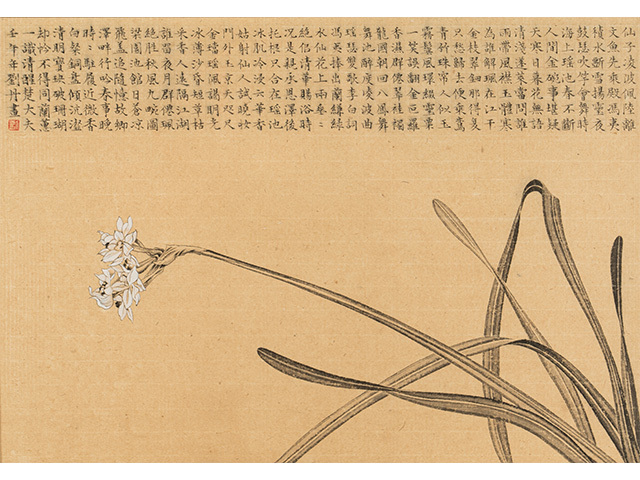
Liu Dan (b. 1953), Narcissus, ink and color on paper, signed and inscribed, 11 x 16 in. (28 x 40.5 cm), estimate $80,000-$120,000.
Whether it is from a life sketch or from a photograph, [the flowers’] shapes are formed initially in order not to forget. Now what has been painted has become the remembered.
– Liu Dan
Liu Dan studied Confucian classics and calligraphy at an early age, and later attended the Jiangsu Traditional Chinese Painting Institute where he studied under artist Ya Ming. However, it was only after moving to the United States in 1981 that he began to associate his art with classical Chinese painting. It was there that he found new opportunities to learn from museum collections of classical paintings.
Painted in 2002, this Narcissus belongs to a series of flower paintings that Liu Dan began in the late 1990s when he was living in New York. Liu delicately painted the slender leaves and the cluster of flowers blooming from an elegant stem, along with fine calligraphy of poems and ancient verses about the narcissus flower. Offering the promise of spring, the narcissus is known in Chinese culture as the "water goddess" (shuixian) or the "goddess who stands above the waves" (lingbo xianzi). The flowers depicted by Liu appear to be more beautiful than in reality. Blossoms are usually transient, and capturing the moments blurs the line between imagination and experience. The portrait of the narcissus appears almost timeless with a serene spiritual energy.
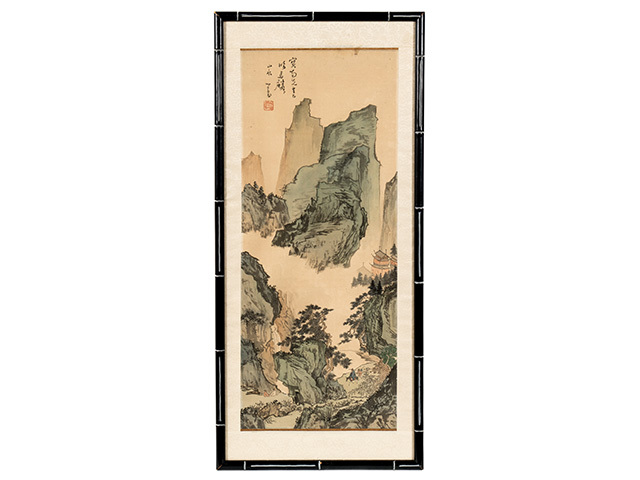
Pu Ru (1896-1963), Landscape, ink and color on paper, 26 1/2 x 11 1/2 in. (67.3 x 29.2 cm.), estimate $5,000-$7,000. Property from the Collection of Cheng Bao-nan, Taiwan, thence by descent.
Chinese painter and calligrapher Pu Ru creates works featuring contemplative themes, landscapes, garden stones, and poems. Born in 1896 in Beijing, the artist began his professional career studying astronomy and biology at the University of Berlin. Returning to the east, the artist began his journey into studying calligraphy and painting and eventually became a professor at National Taiwan Normal University in 1949. Blending natural lush landscapes with striking calligraphy, his work was formally recognized in 1963 with a comprehensive exhibition of his art at the National Museum of History in Taipei. Landscape by Pu Ru features a towering mountain landscape, craggy rocks, and small vignettes of pastoral life.
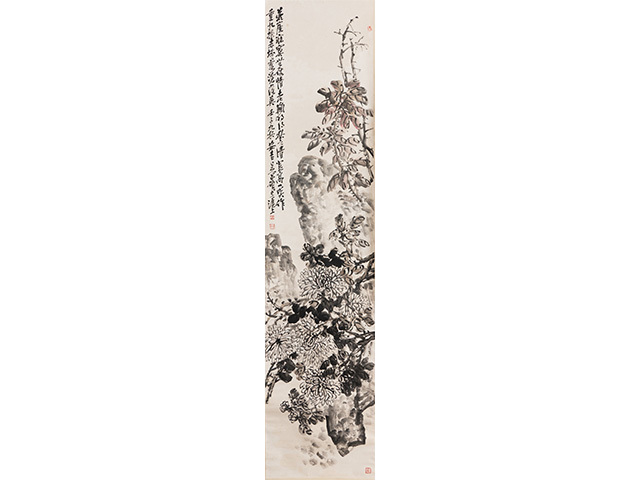
Wu Changshuo (1844-1927), Chrysanthemums, ink and color on paper, 87 x 20 1/2 in. (221 x 52 cm.), estimate $20,000-$30,000. Property from a Private Collection, Taiwan.
Wu Changshuo is best known as a Chinese seal carver, painter, and calligrapher who rose to prominence in the 20th century. Born to a scholarly Chinese family, Wu learned seal carving from Zhe and Anhui schools, thus developing “Wu style” which combined refined artistry with robust forcefulness. The artist arrived at painting later in life at the age of 30, with his work showcasing elements of his calligraphic style. Wu learned from master Zhao Zhiqian (1829-1884), the leading scholar-artist in the late Qing Dynasty, and went on to incorporate the style of epigraphy into his work.
Seen in his work Chrysanthemums, Wu’s style shines in his use of sharp contrasts and mix of bold & simple brushstrokes. The contrast of bold, small leaves within this composition with the dainty petals of the chrysanthemums is punctuated with two pronounced lines of calligraphy to the left, structuring the scroll.
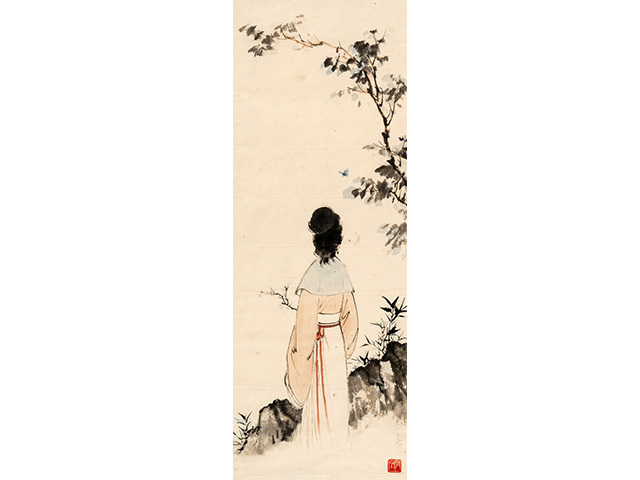
Huang Junbi (1898-1991), Lady, ink and color on paper, 18 1/2 x 7 in. (47 x 17.8 cm.), estimate $1,500-$2,000. Property from the Collection of Cheng Bao-nan, Taiwan, thence by descent.
Considered one of the most influential painters of Modern China, Huang Junbi began his artistic career at an early age. Huang established the Guihai Cooperative Society with several artists in the 1920s, with the aim of championing Chinese painting education. Huang Junbi’s influence is incredibly expansive. Considered a renaissance man, Huang traveled across China examining its natural wonders and informing his work with these landscapes. He studied ancient masters of Chinese painting, eventually developing his renowned “Cloud Mountains and Waterfall” style. His work Lady, an ink and color on paper, shows the back of a distinguished female subject looking out onto a sparse landscape. This exquisite work is relished in its simplicity and contemplative nature.
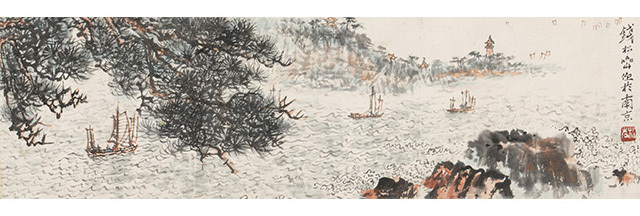
Qian Songyan (1899-1985), Riverscape Scene, ink and color on paper, 32 1/4 in x 15 1/4 in. (82 x 38.7 cm.), estimate $3,000-$5,000. Property from the Estate of Richard S. Ravenal, Livingston Manor, New York.
Qian Songyan’s artistic path began at the turn of the 20th century. Learning from his father, Qian went on to graduate from the Jiangsu Provincial No. Three Normal College in 1923 and went on to even teach at art academies throughout his career. His style frequently features bright splashes of color, robust textural elements, and architectural structures throughout his pieces. Riverscape Scenes opens the viewers up to an expanse of water with three boats dotting the scene. Framed by tree branches, craggy rocks, and a faraway hilly stretch, this scene feels like a moment trapped in time.
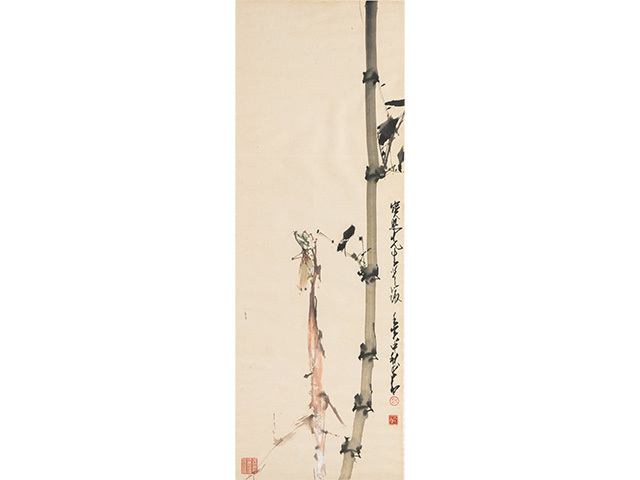
Zhao Shao'ang (1908-1998), Mantis on Bamboo, ink and color on paper, 31 1/2 x 11 1/2, 80 x 29 cm. estimate $7,000-$9,000. Property from the Collection of Cheng Bao-nan, Taiwan, thence by descent.
Considered one of the preeminent flower and bird painters of his era, Zhao Shao’ang was active throughout the 20th century. His work blends impressionism, swaths of vivid color, and strong line work. As an adolescent, Zhao studied with the master Gao Qifeng and eventually became a teacher at Fushan Art Academy in his early 20s.
Throughout his career, the artist has held solo exhibitions in China, Europe, and New Zealand but eventually settled in Hong Kong to complete his career. Coming up for auction this March 28th, Mantis on Bamboo is a study of tranquil nature scenes. Utilizing subtle colors and intricate linework, Zhao’s work is striking in its simultaneous complexity and simplicity.
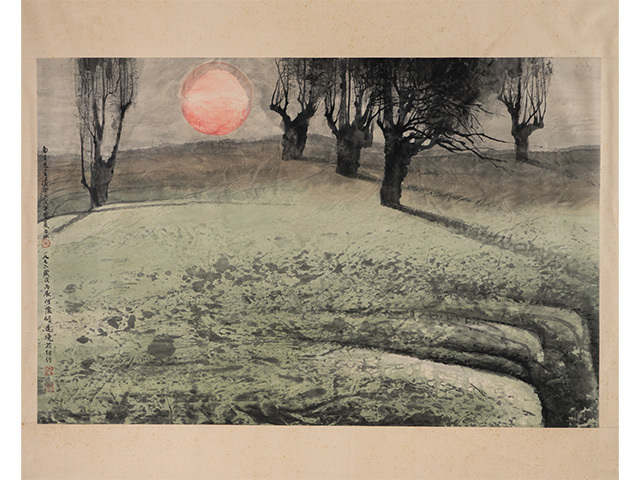
He Huaishuo (b. 1941), Landscape, ink and color on paper, framed signed with a dedication, dated 1978, with three artist seals, Shuo, He, Huaishuo, Estimate: $2,000 - $4,000
He Huaishuo graduated from the National Taiwan Normal University before furthering his education in the United States. The artist is known for rendering elements of traditional Chinese landscape paintings with new techniques and perspectives, whether depicting lone figures or twilight landscapes.
Following in the footsteps of Fu Baoshi, Huang Binhong, and Lin Fengmian, He is most influenced by the latter’s overtly poetic and emotionally expressive images that incorporate Western techniques with ink painting. Like Lin and other modern artists, He’s images fill the picture in rejection of the preferred tradition of balancing negative and positive space. Landscape presents He’s style of traditional in material and contemporary in composition. The fraught landscape depicts an ominous scene marked by an aesthetic of bitter expressionism.